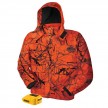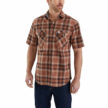Carhartt Jackets and Vest for Outer Layering
Carhartt Jackets and Vest for Outer Layering
A Five-Layer System
The two Carhartt jackets and vest that I describe here represent two possible outer layers in a five-layer modular cold-weather layering system that I’ve developed over the last 50 years. Look up “cold weather layering” and you’ll mostly get descriptions of a three-layer system consisting of a wicking base layer, an insulating layer, and an outer layer to keep out wind, rain, and maybe cold.
That three-layer system comes from winter cold-weather sports such as hiking, mountaineering, and Nordic (cross-country) skiing, where energy output is more-or-less constant over a reasonable period of time. My more complete system was developed as a teenager downhill skiing in Vermont. Downhill skiing consists of interspersed periods of intense exercise (skiing the hard mogul trails) with periods of inactivity while exposed to the wind (riding the chair lift back up the hill). This is more like most construction work in which you are working hard for a bit, then not so hard, then hard again, and so on. Also, in construction, the degree of cold often varies considerably over the course of a day, and you may be going in and out of the weather; both of these conditions benefit from layering flexibility.

I advocate a system consisting of a wicking t-shirt, a wicking mock or traditional turtleneck over that (this is really the key element since heat escapes through the neck), a shirt or sweatshirt next, and then either a vest, a jacket, or a vest and a jacket. I prefer sweatshirts that are not hoodies, since the hood gets in the way of a jacket worn over the sweatshirt (and hoods aren’t allowed on some jobsites in any case). Add in a hat and gloves, and you are prepared for a cold day on the jobsite.
Carhartt is the Standard
Carhartt is the only workwear vendor that makes all the components of my system. And make them they do…in spades (Carhartt makes a lot of products!) I chose these two Carhartt jackets and vest because they provide a flexible range of modular choices that work for me while working in New England winters. If you work in a milder or colder climate the principles here still apply, but you might want to choose somewhat different jackets from Carhartt’s extensive collection.
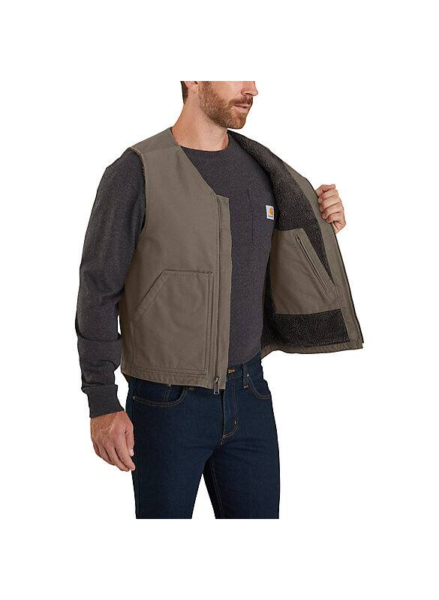
When I was a kid, working alongside my dad and other WWII-era tradesmen, Carhartt was the only really high-end workwear that I was aware of. It was truly rugged stuff, and it was relatively expensive. Now, of course, there are lots of workwear vendors, but Carhartt still makes truly rugged stuff…and it’s the standard to which others are compared Today it’s also cost-competitive.
Warmth Ratings and Fits
If you’re going to layer and dress in a modular fashion, you obviously want to have as many total warmth possibilities as you can. Therefore it only makes sense to have outer layers with different amounts of insulating capability so as to have as many permutations as possible.
Carhartt has recently assigned numerical “warmth ratings” to many of its outerwear pieces. These are: 1 – warm, 2- warmer, 3- warmest, 4- extreme warm. No, these ratings don’t tell you to what temperature the garment will keep you warm – that’s obviously impossible. Rather they provide a relative ranking, which is still extremely useful.
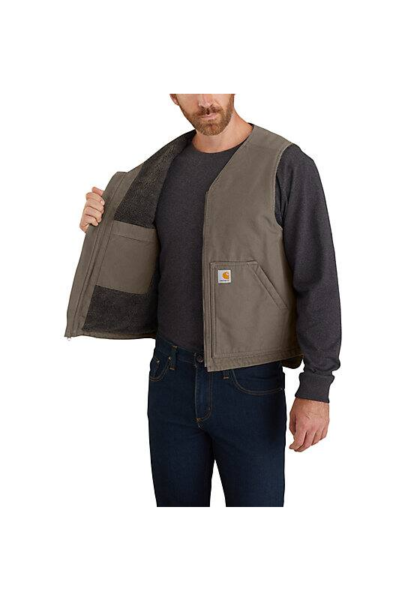
Carhartt jackets also come in two different fits: relaxed and loose. This is another variable you want to pay attention to when designing a modular layering system for yourself. You’ll see how I did this as you read on.
Relaxed Fit Washed Duck Sherpa-Lined Vest
This vest (style 104394) is an updated version of an earlier model (model V26) that was a little shorter in length and had a deeper “V” neck. I used that older version for years (and it still has many years of life in it), but I like this version quite a bit better. This vest covers more of your torso but still allows complete freedom of movement. It also has deeper and slightly more horizontal–opening pockets to hold tools, gloves, phones, and small parts better. Speaking of those pockets, the ones on this vest are typical Carhartt: deep, easy to get hands into and out of, and optimized for storing stuff. They’ve become the industry standard.
Carhartt doesn’t assign their vests a warmth rating, but I’d say it’s a relative “7/8” or maybe a “¾”. In general, I’m between a medium and large size. I got this vest in a (relaxed fit) medium so that it fits comfortably but closely when worn over a sweatshirt and will also fit under one of the jackets I describe below.
Like all the outer layers described here, I went for a cotton duck (canvas) shell. I need my work clothes to be abrasion-resistant, and duck is the standard here. If you prefer something lighter and aren’t as concerned about abrasion, Carhartt makes nylon-shell vests too. I choose a V-neck vest so that when it’s worn under a jacket there aren’t uncomfortable multiple layers of material around my neck.
When I was starting backpacking back in the 70s, experienced backpackers were calling on the outdoor clothing companies to bring more vests to market, because a vest is an extremely useful warmth and sweat-management tool when you’re climbing hard. Ditto for working hard. If you aren’t including a good vest in your cold-weather system, you really need to try one, and this vest is a great choice.
Features
- 12-ounce, 100% ringspun cotton-washed duck
- Sherpa-fleece lining
- Triple-stitched main seams
- Full zip front
- Droptail hem
- Two sherpa-lined front pockets
- Large, rugged zippers that are easy to use with gloves
- Two inner pockets
- Approximately $80 on line
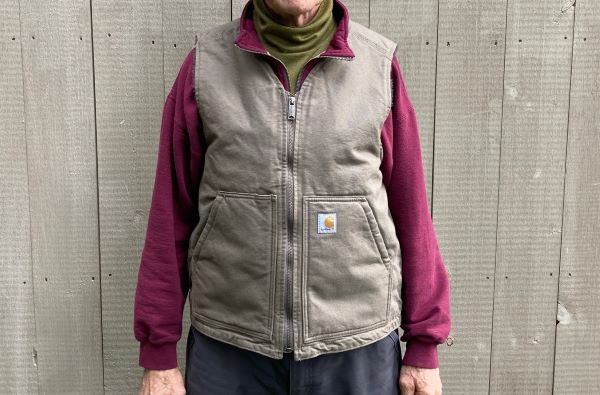
Relaxed Fit Washed Duck Sherpa-Lined Utility Jacket
This jacket, (style 103826) is a “2” rated (“warmer”) jacket, previously known as the Bartlett Jacket. I got it in a relaxed fit, but a large. If I need something warmer than the vest above, I can layer this over the vest, or I can shed the vest and simply wear this. Obviously, I got this jacket in a large so that I could layer it over the medium vest. If I wear it without the vest underneath, well, it’ll just be a little looser on me but no big deal.
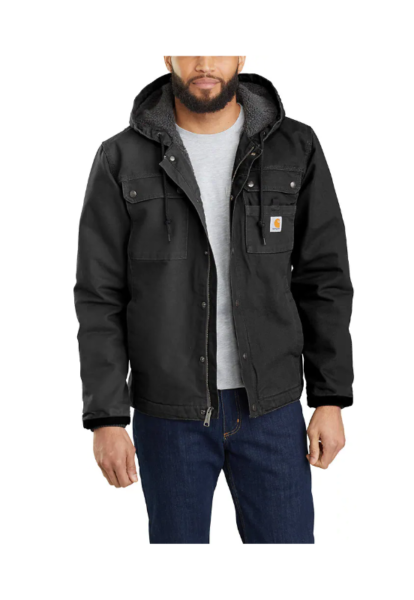
Features
- Heavyweight, 12-Ounce 100% ring-spun washed cotton duck
- Sherpa-lined body for warmth; quilted nylon sleeve lining for easy on-and-off
- Reinforced Cordura® at cuffs; internal rib-knit storm cuffs help keep out the cold
- Triple-stitched main seams
- Pleated bi-swing back for extra stretch across the shoulders
- Attached adjustable hood
- Large, rugged zippers that are easy to use with gloves
- Full-zip front with inner and outer storm flaps and snap-button closure
- Drawcord-adjustable droptail hem for added coverage
- Two snap-button chest pockets; two lower front pockets
- Two inside pockets
- Approximately $140 on line
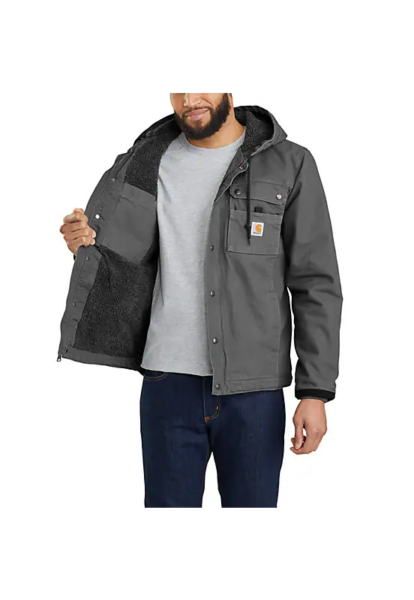
Again, we’ve got a duck shell here for abrasion resistance. Washed Duck is, as the name suggests, cotton duck that has been washed with detergent, which softens up somewhat stiff unwashed (“Firm Duck” in Carhartt parlance) duck material.
And look at the number of functional features: cuffs reinforced with Cordura (cuffs tend to fray), a pleated back so your arms can move freely without binding, a storm flap to cover the zipper, and the drawcord adjustable droptail. These are the kinds of real-world useful features that separate a well-made and well-thought out work garment from one that’s bare-bones. There are also plenty of secure pockets to accommodate all the kinds of things that a construction worker typically stows.
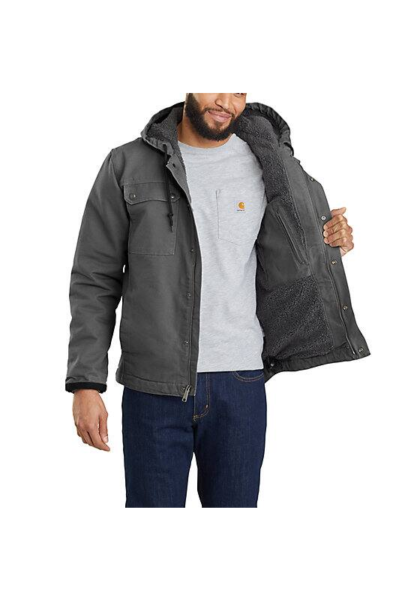
This is a warm jacket. With the vest it’s quite warm. The two garments would get me through much of the cold weather work days here in western Massachusetts, particularly if I’m active, and often when I’m not. Typically I throw all of the layers I think I might need during the day in my vehicle and swap them out as necessary as the day progresses.
I wasn’t sure if I’d like the recessed rib-knit cuffs. I assume that Carhartt constructed the cuffs this way (I’ve heard this construction described as “storm cuffs”) because exposed rib-knit cuffs tend to get abraded and fray, but I wondered if the Cordura reinforced sleeve cuffs would interfere with the operation of tools. They haven’t, I’m happy to report, partially because they aren’t too wide at the wrist and because the sleeve length fits me (I take a 34-inch shirt sleeve length).

Loose Fit Washed Duck Insulated Active Jac
Carhartt introduced the Active Jac style in 1975, and they make several variations of it. This jacket (style 104050) is the updated version of the very popular J130 jacket; it clocks in at a “3” warm rating.
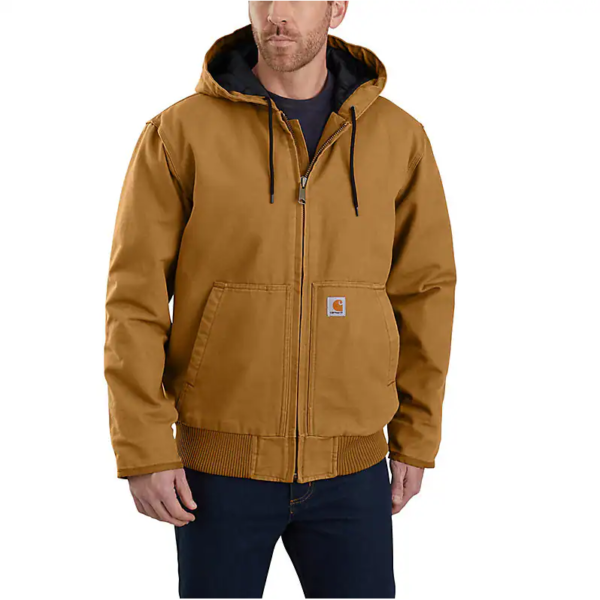
Before I ever owned an Active Jac, I couldn’t see why they were so popular…but I figured it out! Their plain looks belie the genius of the design. I think of them as a zip-up sweatshirt with better insulation, a tough shell, rib-knit waist and cuffs, work-optimized pockets, and all with the freedom of movement of a sweatshirt. Also, they are the right length for any kind of sitting, such as in a truck or cab, which we all do part of most days.
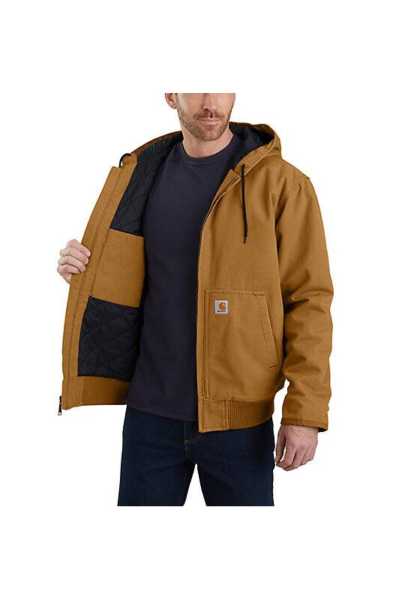
Features
- Heavyweight, 12-Ounce 100% ring-spun washed cotton duck
- Quilted nylon lining; 80g 3M™ Thinsulate™ featherless insulation
- Triple-stitched main seams
- Cordura®-reinforced sleeve hems resist wear and tear
- Full-zip front
- Attached hood with inner drawcord and cord-lock
- Internal rib-knit storm cuffs
- Elbow pleats for ease of movement
- Two lined front pockets, one with pen stall
- Large, rugged zippers that are easy to use with gloves
- Two inner pockets
- Back length of large regular: 28.5″
- Approximately $120 online
The duck shell is, again, important for abrasion resistance. The Thinsulate insulation is high-tech stuff that provides warmth with low bulk and weight. The rib-knit waist and cuffs are important on a very cold-weather jacket – if cold wind can get under your jacket you almost might as well not be wearing one. (The drawcord-adjustable droptail hem on the Utility Jacket above serves much of this function, but it isn’t as necessary on that lighter jacket.)
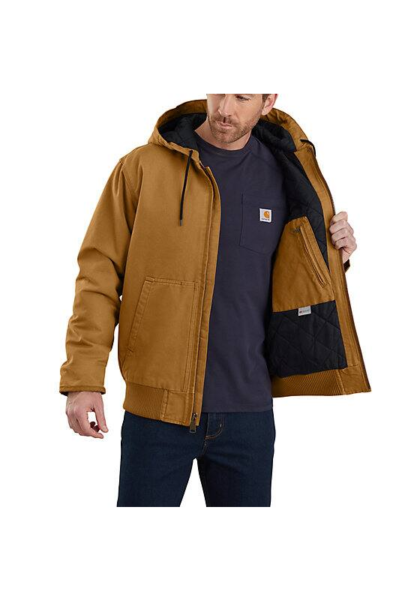
I mentioned above that I don’t like hoods on sweatshirts because they get in the way when you layer over them. On outer layers though, I’m agnostic. If you like them, and your jobsite allows them (they obstruct vision and get snagged on machinery), then many Carhartt jackets incorporate them. If you don’t care for them, they are easy enough to ignore.
That said, hoods can be a real Godsend in extremely cold weather. While I don’t usually use them, I recall last winter when it was minus 20-degrees with a stiff wind, and of course I had to work outside. The hood was welcome then.
So if, as I mentioned above, the “2”-rated Utility Jacket with the sherpa-lined vest will get me through much of the New England winters, why would I need a “3”-rated active jac? Two reasons. Sometimes your activity may not be generating much heat — operating machinery is a good example. Also, recall that minus 20-degree day I mentioned – sometimes it just gets really, really cold.

Criticisms?
I haven’t criticized these two Carhartt jackets and vest, and it’s because I don’t really find any fault with them. There might be a couple little tweaks that I’d prefer, but 1) they would be very minor, and 2) they’d just be personal preferences anyway. Carhartt has been doing this for a long time (since 1889 actually) and they pretty much have the recipe nailed. The current lineup of Carhartt garments is the result of over 120 years of refinement, focus, and staying close to their customers.
In fact, the most criticism you hear directed at Carhartt comes when they tweak – or worse, discontinue – a product that had a loyal following. But for every tweak that someone dislikes, there are more working people who appreciate it. And every company has to discontinue products that aren’t selling well – in fact, Carhartt no longer sells one of my favorite pants (the Cryder) that I wrote about here, but I don’t hold it against them.
If you want to stay warm in the winter, give my five-layer system a trial. If you go with Carhartt for the layers you’ll also be guaranteed workwear as rugged and well-designed as it comes.




